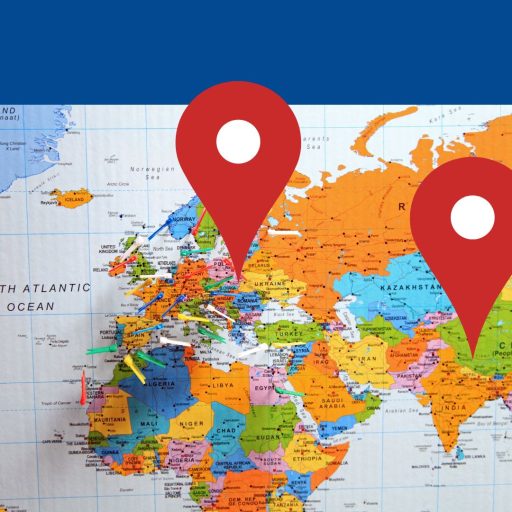Europe versus Asia in the Development of the World Economy
29 Kasım 2022Aslı Düzenli Umur
Today we are living in a global world. As discussed with Terence Joseph Holden in KHAS 103 Lectures, people and communities, even those far away from each other, show similarities as the cross-cultural exchange are immense. There is a strong interdependence among nations in areas such as economics and politics. The world has become a single world community. Even though the presence of the global human web is a commonly accepted fact in our day, the world has not always been that connected. It is the 1400s- 1800s that the human web started to form and develop. Under the rule of empires, such as the Ottoman, Safavid, Mogul, and Chinese, different human populations were unified. Thanks to these empires and the exploration of people from sea states such as the British, Spanish, Dutch, and Portuguese, new foods were planted all over the world and raw materials were carried to distant locations. Throughout these centuries, economies were transformed via specialization in production; hence interdependence soared. Price changes in different countries started to synchronize. The question of whether the world economy was formed around the Europeans’ activities or whether were there other sources of agency in the period between 1400-1800 has always been an area of discussion with contradicting answers. The Eurocentric interpretation suggests that the central agency of the change was Europe and all the peripheral civilizations were transformed by the Europeans. On the contrary, there is also strong evidence of a regional web in Asia already before the 1400s. In this paper, I will argue that even though Europe was not better off on the Asian peninsula in economic terms, it turned out to be lucky for the Industrial Revolution in the 19th century.
First of all, Europe achieved significant progress between the 1400 and 1800s which drastically extended its realm of impact. As discussed by McNeil (McNeil, 2003, pp. 163-164), by the 15th century, Europe was able to build larger, cheaper, and stronger ships and they had accumulated the required navigational know-how. Thanks to the stable ships they built, they were able to place shipboard cannons required for safety in open seas. Hence already before the end of the 15th century, the Portuguese were able to go anywhere on the high seas (McNeil, 2003, p. 164). The improved navigational capabilities of the Europeans enabled them to become a major player in international trade. Vasco de Gama’s travel to the Indian Ocean was a historical turning point, linking the Atlantic and the Indian ocean. Through this achievement, Europe found a way to escape Ottoman control of trade between Europe and Asia. While the Portuguese took control of the trade route it was the Dutch who took control of production. Trade monopolies of Dutch, British, and French controlled the production and trade of goods such as cotton and spices between Europe and Asia, and among Asian countries. American silver was traded by Europeans in exchange for goods and slaves. With all these improved capabilities, Europe also started to heavily impact the culture of countries which were brought into the human web. The production of valuable goods such as tobacco and sugar in the Americas boosted the demand for slaves; almost 25 million people were enslaved in Africa (McNeil, 2003, p. 169). The Cape was turned into an agricultural colony where Dutch religion and language spread (McNeil, 2003, p. 168). Hence Europe became the center between the East and the West and bridged Asia, Africa, and America.
Contrary to the Eurocentric interpretation, Asia preserved economic strength till the end of the 1800s. Hobson (2004) provides evidence of Asian dominance until the 19th cc with statistics in his study named ‘The Eastern Origins of Western Civilizations’. yield, with reference to Paul Bairoch, he states that even as late as 1860 total income of Eastern (Afro-Asia) was 35% higher than the Western income (Europe, Americas, Russia, and Japan) (Hobson, 2004, p. 75). The figures reveal a different story when the comparison is based on per capita income as the population in the East was higher. Even with this measurement favored by Eurocentric writers, he states that around the 1750s the West was almost equal to the East (Hobson, 2004, p. 76). It was as late as the 1860s that the British share in global production caught that of China (Hobson, 2004, p. 76). Along with income figures, a comparison could be made based on qualitative measurements. When Asia is compared to Europe in living standards, it was not worse than Europe till the 2nd half of 18th cc. With reference to Pomeranz, Hobson states that Ottoman living standards and real wage rates were not lower than in Europe until the 1900s. He also mentions the trade deficit Europe had with the Eastern powers throughout this period signals the backwardness of Europe (Hobson, 2004, p. 78). In a nutshell, economic indicators verify that Asia was not lacking behind in economic strength in comparison to Europe until the beginning of the 1800s. it was not worse than Europe till the 2nd half of 18th cc. With reference to Pomeranz, Hobson states that Ottoman living standards and real wage rates were not lower than in Europe until the 1900s. He also mentions the trade deficit Europe had with the Eastern powers throughout this period signals the backwardness of Europe (Hobson, 2004, p. 78). In a nutshell, economic indicators verify that Asia was not lacking behind in economic strength in comparison to Europe until the beginning of the 1800s. it was not worse than Europe till the 2nd half of 18th cc. With reference to Pomeranz, Hobson states that Ottoman living standards and real wage rates were not lower than in Europe until the 1900s. He also mentions the trade deficit Europe had with the Eastern powers throughout this period signals the backwardness of Europe (Hobson, 2004, p. 78). In a nutshell, economic indicators verify that Asia was not lacking behind in economic strength in comparison to Europe until the beginning of the 1800s.
As indicated by the economic figures above, Asia had its regional human web already running before the arrival of Europeans. There was already a sizable international trade in the region, both inland and overseas. For instance, Melaka, a principal trade city in Southeastern Asia, which was dominated by the Portuguese in 1511, had already been active in trade a century earlier (Hobson, 2004, p 87). Contrary to the Eurocentric argument that all the world, except Europe, was composed of empires fighting with each other, there was a vivid trade flow among Ottomans, Safavids, Mughals, and Uzbeks. The rulers in these empires supported trade by building the road network and hostels for traders (kervansaray).
There were also strong and wealthy trade networks in Asia that leveraged diasporas. The Indian trade network was composed of very prosperous merchants who had a global reach in the cotton trade. The Chinese diaspora connected Asian and American markets, despite the fact that officially international trade was forbidden. The Armenian trade network, centered in New Julfa , established a global trade network thanks to trusted family members in different locations spread throughout the world . There was continuous business correspondence among themselves via both maritime and overland routes. In a very structured manner, these business correspondences provided information on political and social news, the trustworthiness of merchants , and news about commerce such as price lists ( Aslanian, 2001, pp . 96-97 ) . The Armenian merchants also provided financing for the merchants. They were nothing resembling the peddlers, as suggested by the Eurocentric interpretation. Hobson argues that the presence of extremely wealthy merchants in the Indian market defeats the Eurocentric argument that the despotic rulers of Asia dried economies as they stole economic resources from their people. (Hobson, 2004, p 82) Hence, Asia already had a very well-established, large , and complex trade network that Europeans had very limited impact on when they approached the Asian market.
In conclusion, in the period of the 1400s-1800s, Europe was gaining economic power thanks to its advancement in navigational technology and know-how. The Atlantic Europeans became a linkage between Asia, the Americas, and Africa while they built up their economic prosperity as well as set up their cultural dominance over peripheral states. On the other hand, in this period Asia was still strong and kept its regional human web intact. However, in the 19th cc, it was Europe that realized the Industrial Revolution. The Eurocentric view argues that it was the uniqueness of Europe that opened the pathway for industrialization and Asia stagnated as its rulers blocked technological and economic development. One sound argument to this question refers to natural barriers to expansion. Europe expanded overseas, into new lands of America which they repopulated and extracted its raw materials. On top, Britain had vast coal mines, which became the fuel of industrialization. China also expanded westwards however it was an inland expansion and it moved its center away from coal-producing centers. I strongly believe that throughout the 1400s-1800s both Europe and Asia had established and expanded human webs. With the incomparable boost of the Industrial Revolution, Europe started to dominate the global community.
References
- Khas 103. (2021). Terence Joseph Holden Lectures.
- McNeil, JR, & McNeil, WH (2003). The human web: A bird’s eye view of World History . W. W. Norton and Company.
- Aslanian, D, S. (2001) Chapter 5 The Salt in the Merchant’s Letter. In From the Indian Ocean to the Mediterranean: The global network of Armenian merchants from New Julfa (pp. 86-120). University of California Press.
- Hobson, J. (2004). The Eastern Origins of Western Civilization. Cambridge University Press.

